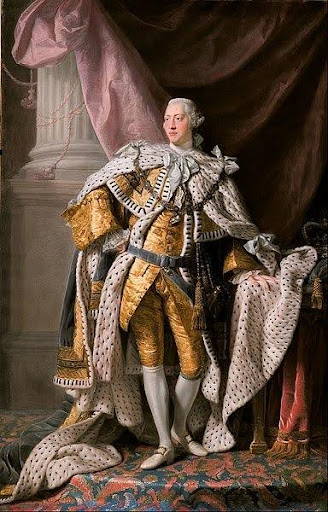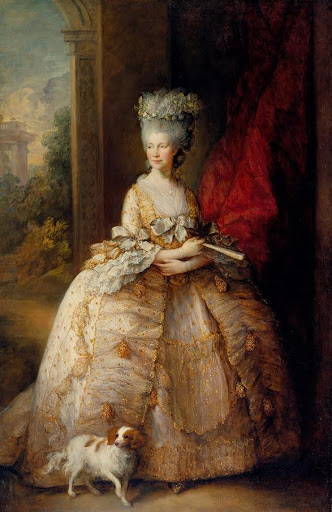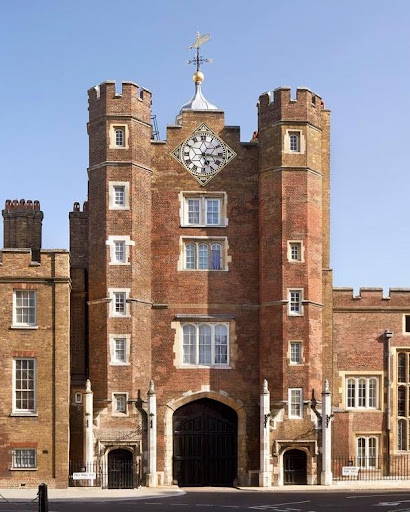Adelaide Magnolia Letter 21 - A Royal Marriage and Home
King George III and Queen Charlotte

King George III in Coronation Robes. 1765 Allan Ramsay. Courtesy of the Art Gallery of South Australia.

Queen Charlotte (1744-1818). 1781 Thomas Gainsborough. Courtesy of the Royal Collection Trust.
King George III, born on June 4, 1738, ascended the British throne in 1760, marking the beginning of a reign that would span nearly six decades. His marriage to Charlotte of Mecklenburg-Strelitz occurred on September 8, 1761. Charlotte, born on May 19, 1744 in the Duchy of Mecklenburg-Strelitz (now part of Germany), was chosen as George's bride after a brief courtship arranged by their families. Their union began as an attempt for King George to establish stability as monarch and maintain political ties with Germany, but it was also a genuine partnership characterized by mutual respect and affection. Charlotte was known for her modesty, grace, and devotion to her family. The couple would attend events together and would even perform duets with each other on the harpsichord and flute. The couple had 15 children together, 13 of whom reached adulthood.
The first half of George’s reign was filled with political ups and downs. He came into his reign (1760) during the Seven Year’s war, where Britain came out victorious over France and established itself as a major European power abroad. However, British colonies were lost not long after that in the American War of Independence. King George was blamed by his political opponents for prolonging the war and increasing the expense upon the Kingdom. In the decades to follow George experienced both wins and losses politically, but was also viewed by many as a good king who favored progress and approached his rule with sincerity. Additionally, his devotion to his wife and family made him unique as a monarch and favorable to his subjects.
Charlotte was a devoted and loyal Queen Consort, wife, and mother. Coming to England, not speaking the language, and not having any connections required a period of adjustment. Despite these barriers, Charlotte became known widely in society as a lover of art and music, attending concerts, and, along with the king, a great supporter of German artists and composers. Her involvement in founding the Queen Charlotte's Maternity Hospital in London and her support for orphanages demonstrated her commitment to social welfare.
One aspect of Charlotte's life that generated rumors, however, was her racial heritage. Though some during her life time may have remarked on her complexion being not as white as other European royalty, the true breadth of rumors of her ancestry did not sprout until the 1920’s when a German historian noted the differences in her painted portraits and highlighted that one portrayed her with having more “African” features. Some historians and genealogists now claim that Charlotte may have had North African or Moorish ancestry from her maternal grandmother’s line dating back to the 13th century. But even today there is controversy over this one ancestor of Charlotte’s and what her ethnicity really was. In the end, there really is no concrete proof to confirm or deny these claims and most scholars, as well as the Royal Family, denounce these claims and don’t spend too much time dwelling on them.
Despite the possible speculation, King George III and Charlotte's marriage was stable and happy until King George started experiencing episodes of mental illness. In 1788 he had a long bought of mania, delirium, convulsions, and violent behavior. George experienced additional, but shorter, episodes in both 1801 and 1804. During these episodes, George was moved to Dutch House at Kew Palace where he was watched over by his physicians. After each relapse and recovery, it became apparent the King’s mental and physical health was deteriorating. In 1810, after becoming blind from cataracts, he experienced his final relapse. This episode rendered King George III permanently insane. In this state it was necessary for parliament to pass the Regency Act of 1811, appointing his son, the Prince of Wales, as Prince Regent during the remainder of the King’s lifetime.
During the time of the Regency, Queen Charlotte continued her official role as reigning Queen and was host alongside her son for state functions. By this time, Charlotte was afraid to visit her spouse because of his erratic behavior and violence, but she remained supportive from a distance and was his legal guardian. Sadly, in 1818, Queen Charlotte suffered a stroke, and her health declined rapidly. She passed away on the 17th of November. King George’s mental state was so deteriorated by this point, that he was unable to recognize that his wife had passed away. He survived his wife by roughly 14 months and passed away from pneumonia on January 29th, 1820.
St. James’s Palace

The Exterior of St. James’s Palace. Courtesy of the Royal Collection Trust
St. James’s palace is located in Westminster in central London and is the most senior royal palace. It is one of the oldest and most prestigious palaces in the city and holds a unique place in British royal history. Built by Henry VIII in the 1530’s, the palace has served various functions over the years, including as a royal residence, a court, and a place for official ceremonies.
One of its notable features is the impressive red-brick Tudor architecture, which contrasts with the grandeur of nearby Buckingham Palace. St. James's Palace has been a residence for many British monarchs, including Queen Mary I and Queen Anne, and continues to be a significant location for various royal events, such as investitures and diplomatic receptions.
While it is no longer a primary royal residence, St. James's Palace remains a symbol of tradition and history, and the Chapel Royal within its walls is still used for important religious ceremonies. The palace's location near St. James's Park and Westminster makes it a central part of the capital's historic and cultural landscape, allowing visitors to appreciate its rich history and architectural beauty.
Learn the Vernacular:
Up to snuff: meeting an acceptable standard
Watering pot: someone who cries too much
St. James Park: 57 acre urban park in Westminster, London adjacent to St. James’s Palace with Buckingham Palace on its western side
Sources:
https://www.hrp.org.uk/kew-palace/history-and-stories/queen-charlotte/
https://en.wikipedia.org/wiki/George_III
https://www.britannica.com/biography/George-III
https://www.theguardian.com/world/2009/mar/12/race-monarchy
https://en.wikipedia.org/wiki/Charlotte_of_Mecklenburg-Strelitz/
https://www.ncbi.nlm.nih.gov/pmc/articles/PMC4953321/
https://www.pbs.org/wgbh/americanexperience/features/adams-king-george-III/
https://www.history.co.uk/articles/king-george-iiis-descent-into-madness-a-tale-of-royal-tragedy
https://en.wikipedia.org/wiki/St_James%27s_Palace
https://www.royal.uk/royal-residences-st-jamess-palace
https://www.rct.uk/8-surprising-facts-about-st-jamess-palace
